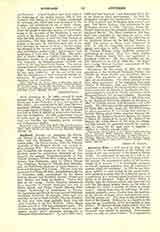

Auckland, Diocese of, comprises the Provincial District of Auckland (New Zealand), with its islets, and the Kermadec Group. Area, 21,665 square miles. On Trinity Sunday, 1835, the Vicariate Apostolic of the Western Pacific was erected by Pope Gregory XVI. The Abbe Jean Baptiste Francois Pompallier was chosen as its first vicar. The territory under his jurisdiction comprised all New Zealand, the present Vicariates Apostolic of Fiji, Central Oceanica, British New Guinea, Dutch New Guinea, New Pomerania, (part of) Gilbert Islands New Caledonia, Navigators’ Islands, New Hebrides, and the Prefectures Apostolic of North Solomon Islands and Northern New Guinea. The new vicar was consecrated in Rome, June 30, and sailed from Havre, December 24, 1836, accompanied by the Marist Fathers Servant and Bataillon (Lyons), Chanel and Bret (Belley), and three laybrothers. Father Bret died on the voyage. Father Bataillon (afterwards Vicar Apostolic of Central Oceanica) was left at Wallis Island, and Father Chanel (Blessed Peter Chanel, Protomartyr of Australasia) at Futuna. Dr. Pompallier and Father Servant reached Hokianga (Auckland Province) January 10, 1838, and were provided for by an Irish Catholic, Thomas Poynton. At that time there were probably fewer than 100 white Catholics in all New Zealand. Other Marist Fathers arrived in 1839 and subsequent years. The missions to the aborigines (Maoris) became very successful, despite grave calumnies propagated by Wesleyan trader-missionaries. By April, 1846, about 5,000 had been baptized, “and there were about five or six times as many catechumens.” In 1845 Dr. Pompallier changed his headquarters to Auckland. In 1848 Auckand and Wellington were erected into sees. The Marist Fathers were withdrawn to the Wellington diocese in 1850. The Rev. James Mc-Donald then became the principal missionary to the Auckland Maoris. The Maori missions in New Zealand were paralyzed by the series of native wars between 1843 and 1869. They were taken up in the Auckland diocese by the Mill Hill Fathers, in 1886. The Sisters of Mercy were introduced in 1850. In 1868 Dr. Pompallier went to France, resigned, and died in 1870. He was succeeded by Dr. Thomas William Croke (1870-74), afterwards Archbishop of Cashel. After five years, Father Walter Bisschop Steins, S.J., was appointed to Auckland (1879-81). He was succeeded by Dr. John Edmund Luck, O.S.B. (1882-96). The Right Rev. George Michael Lenihan, consecrated November 15, 1896, succeeded him.
STATISTICS.—At the census of 1901, the white population of the Auckland Provincial District was 175,938 (of whom 27,246 were Catholics); Maoris, 21,291. The population of the Kermadecs was eight, all non-Catholics. The official estimate of the total white population of the Auckland Provincial District, December 31, 1906, was 211,233; Catholic population of Auckland Provincial District (which is coterminous with the Diocese of Auckland if the Kermadec Islands be included), 32,272; population of the Kermadec Islands, five, all non-Catholics. According to “New Zealand Statistics, 1904″, p. 503, there were in the Auckland Provincial District, at the close of 1904, 37 Catholic schools, with 96 teachers and 2,393 pupils. The following were the ecclesiastical statistics for April, 1906: secular clergy, 26; Mill Hill Fathers, for native population, 9; for whites and natives, 7; Catholic Maoris, about 5,000; parochial districts, 29; churches, 79; Religious Brothers, Marists, 12; Sisters of Mercy, 97; Sisters of St. Joseph, 36; Sisters of the Mission, 30; Little Sisters of the Poor, 8; colleges and high schools, 13; parochial schools, 25; orphanages, 2; home for the aged poor, 1; hospital. 1; children in Catholic schools, 2,600.
HENRY W. CLEARY

